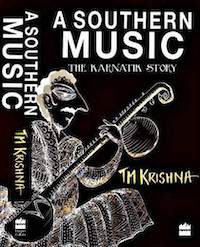
In his recent book, A Southern Music: The Karnatik Story, T.M. Krishna reflects on those misconceptions and stereotypes that stand in the way of truly appreciating South Indian music. He reiterates the unique role played by the (acoustic) tambura / tanpura which is all too rarely heard ‘live’ in Indian concerts today.
For this eminent singer “it is the one instrument that can be said to hold within itself the very essence of classical music. So unobtrusive is this instrument, so self-effacing in its positioning on the stage and so tender of nature, that it is almost taken for granted. It is the life-giver, the soul of our music. … Only a musician who has experienced this sanctity can be a true musical vehicle. In the internal absorption of the tambura’s resonance, music happens.” (pp. 48-50) He asks whether the electronic tambura satisfies the human sense of tune when digitization really changes the manner in which we hear sound, a phenomenon he has explored in practice.
In his view, the practice of substituting the tambura by electronic devices also in the classroom “has worked to the detriment of sruti. All this has consolidated the misconception of Karnatic music going ‘off key'”. (p. 235-6; see the book’s index for more on this and related topics)
Publisher’s note
One of the foremost Karnatik vocalists today, T.M. Krishna writes lucidly and passionately about the form, its history, its problems and where it stands today
T.M. Krishna begins his sweeping exploration of the tradition of Karnatik music with a fundamental question: what is music? Taking nothing for granted and addressing readers from across the spectrum – musicians, musicologists as well as laypeople – Krishna provides a path-breaking overview of south Indian classical music. – HarperCollins Publisher (2013) Price: Rs. 699
As performers-cum-teachers, we should practise with the traditional tambura and teach music with the same to the students.
Malladi Brothers quoted by Aruna Chandaraju in The Hindu >>
Learn more about the tambura (tanpura) >>
Tambura posture, fingering & therapeutic effect
By Rama Kausalya
The Tambura is considered queen among the Sruti vadhyas such as Ektar, Dotar, Tuntina, Ottu and Donai. Although tamburas are traditionally made at several places, the Thanjavur Tambura has a special charm.
Veena Asaris are the Tambura makers too but not all are experts, the reason being it requires a special skill to make the convex ‘Meppalagai’ or the plate covering the ‘Kudam’ (Paanai).
There are two ways of holding a Tambura. One is the “Urdhva” – upright posture, as in concerts. Placing the Tambura on the right thigh is the general practice. The other is to place it on the floor in front of the person who is strumming it. While practising or singing casually, it can be placed horizontally on the lap.
The middle finger and index finger are used to strum the Tambura. Of the four strings, the ‘Panchamam’, which is at the farther end is plucked by the middle finger followed by the successive plucking of ‘Sārani’, ‘Anusārani’ and ‘Mandara’ strings one after the other by the index finger. This exercise is repeated in a loop resulting in the reverberating sruti.
Sit in a quiet place with eyes closed and listen to the sa-pa-sa notes of a perfectly tuned Tambura – the effect is therapeutic.
Except a few, the current generation prefers electronic sruti accompaniment, portability being the obvious reason. Besides few music students are taught to tune and play the tambura. Beyond all this what seems to swing the vote is that the electronic sruti equipment with its heavy tonal quality can cover up when the sruti goes astray.
During the middle of the last century, Miraj Tambura (next only to the vintage Thanjavur) was a rage among music students, who were captivated by its tonal quality with high precision and the beautiful, natural gourd resonators.
Source: “Therapeutic effect”, The Hindu (Friday Review), 30 March 2018
Up-to-date press coverage of person and topics
Periodicals and sites included | More resources | Disclaimer >>
Learn & practice more
A brief introduction to Carnatic music (with music examples and interactive map)
Bhava and Rasa explained by V. Premalatha
Free “flow” exercises on this website
Introduction (values in the light of modernity)
Video | Keeping tala with hand gestures: Adi (8 beats) & Misra chapu (7 beats)
Why Carnatic Music Matters More Than Ever
Worldcat.org book and journal search (including Open Access)